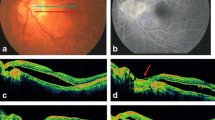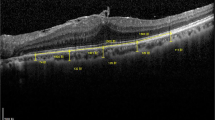Abstract
Purpose
To determine the incidence and characteristics of intrachoroidal cavitation (ICC) in the eyes with high myopia.
Methods
In this retrospective, non-interventional, comparative study, we analysed the case records of 108 eyes with and without pathological myopia (PM). PM was defined as having a refractive error (spherical equivalent) of ≥ − 6.0 D or axial length ≥ 26 mm. The presence of other features like posterior vitreous detachment, myopic traction maculopathy, posterior staphyloma, focal/patchy chorioretinal atrophy (CRA), choroidal neovascularisation and retinoschisis was looked for on OCT. The association of these features with ICC was analysed using statistical tests.
Results
In this study, 38 out of 68 eyes with PM and 4 out of 40 eyes with non-PM showed the bowing of the posterior sclera and the presence of ICC. On statistical analysis with Chi-square test and multiple variable linear regression analysis tests, it was identified that the presence of focal/patchy CRA (p = 0.005) and intrascleral vessels (p = 0.018) in and around the cavitation was important features noted in eyes with ICC. The OCT features of macular and peripapillary ICC were similar. The transudation of fluid from the dilated intrascleral vessels in and around the ICC could be one other mechanism responsible for the development of ICC.
Conclusion
ICC is seen in 55.8% of highly myopic eyes with the presence of focal CRA or myopic conus and/or presence of intrascleral vessels near the cavitation. These findings suggest that patchy atrophy affects the scleral contour within posterior staphyloma beyond the funduscopically identified patchy atrophy by ICC. The presence of intrascleral vessels could also contribute to the ICC development. Eyes with patchy CRA or myopic conus needs to be checked on further follow-up visits for the development of macular or peripapillary ICC.





Similar content being viewed by others
Abbreviations
- PM:
-
Pathological myopia
- OCT:
-
Optical coherence tomography
- ICC:
-
Intrachoroidal cavitation
- MTM:
-
Myopic traction maculopathy
- CNV:
-
Choroidal neovascularisation
- CRA:
-
Chorioretinal atrophy
- PVD:
-
Posterior vitreous detachment
- PS:
-
Posterior staphyloma
- SE:
-
Spherical equivalent
- AL:
-
Axial length
References
Curtin BJ (1979) Physiologic vs pathologic myopia: genetics vs environment. Ophthalmology 86:681–691
Faghihi H, Hajizadeh F, Riazi-Esfahani M (2010) Optical coherence tomographic findings in highly myopic eyes. J Ophthalmic Vis Res 5:110–121
Gohil R, Sivaprasad S, Han LT et al (2015) Myopic foveoschisis: a clinical review. Eye Lond Engl 29:593–601. https://doi.org/10.1038/eye.2014.311
Marticorena-Álvarez P, Clement-Fernández F, Iglesias-Ussel L (2014) Peripapillary intrachoroidal cavitation in pathological myopia. Arch Soc Esp Oftalmol 89:316–319. https://doi.org/10.1016/j.oftal.2013.06.008
Fellman RL, Grover DS (2012) Myopic peripapillary sinkhole: prolapse of retinal nerve fiber layer and posterior vitreous into a sclerochoroidal hollow causing peripapillary choroidal thickening and cavitation. Arch Ophthalmol Chic Ill 1960 130:1220–1221. https://doi.org/10.1001/archophthalmol.2012.441
Bruyère E, Miere A, Cohen SY et al (2017) Neovascularization secondary to high myopia imaged by optical coherence tomography angiography. Retina Phila Pa 37:2095–2101. https://doi.org/10.1097/IAE.0000000000001456
Melikhova MV, Gatsu MV, Boiko EV et al (2018) Dome-shaped macula: features of differential diagnostics with clinical examples. Vestn oftalmol 134:86–94. https://doi.org/10.17116/oftalma2018134386
Freund KB, Ciardella AP, Yannuzzi LA et al (2003) Peripapillary detachment in pathologic myopia. Arch Ophthalmol Chic Ill 1960 121:197–204
Toranzo J, Cohen SY, Erginay A, Gaudric A (2005) Peripapillary intrachoroidal cavitation in myopia. Am J Ophthalmol 140:731–732. https://doi.org/10.1016/j.ajo.2005.03.063
Wei Y-H, Yang C-M, Chen M-S et al (2009) Peripapillary intrachoroidal cavitation in high myopia: reappraisal. Eye Lond Engl 23:141–144. https://doi.org/10.1038/sj.eye.6702961
Spaide RF, Akiba M, Ohno-Matsui K (2012) Evaluation of peripapillary intrachoroidal cavitation with swept source and enhanced depth imaging optical coherence tomography. Retina Phila Pa 32:1037–1044. https://doi.org/10.1097/IAE.0b013e318242b9c0
Shimada N, Ohno-Matsui K, Nishimuta A et al (2007) Peripapillary changes detected by optical coherence tomography in eyes with high myopia. Ophthalmology 114:2070–2076. https://doi.org/10.1016/j.ophtha.2007.01.016
Ohno-Matsui K, Akiba M, Moriyama M et al (2012) Intrachoroidal cavitation in macular area of eyes with pathologic myopia. Am J Ophthalmol 154:382–393. https://doi.org/10.1016/j.ajo.2012.02.010
Holak SA, Holak N, Holak HM (2014) Peripapillary choroidal cavitation. Ophthalmology 121:e6–e7. https://doi.org/10.1016/j.ophtha.2013.09.039
Agorogiannis EI, Parkes C (2019) Optic disc pit with peripapillary retinoschisis misdiagnosed as glaucoma. JAMA Ophthalmol 137:e183851. https://doi.org/10.1001/jamaophthalmol.2018.3851
Gregory-Roberts EM, Mateo C, Corcóstegui B et al (2013) Optic disk pit morphology and retinal detachment: optical coherence tomography with intraoperative correlation. Retina Phila Pa 33:363–370. https://doi.org/10.1097/IAE.0b013e318263d0a6
Yoshikawa T, Nishimura T, Minamino K, Takahashi K (2013) A long-term follow-up of peripapillary retinoschisis with optic disc hypoplasia. Int Ophthalmol 33:425–428. https://doi.org/10.1007/s10792-012-9673-7
Akimoto M, Akagi T, Okazaki K, Chihara E (2012) Recurrent macular detachment and retinoschisis associated with intrachoroidal cavitation in a normal eye. Case Rep Ophthalmol 3:169–174. https://doi.org/10.1159/000339292
Farjad H, Besada E, Frauens BJ (2010) Peripapillary schisis with serous detachment in advanced glaucoma. Optom Vis Sci Off Publ Am Acad Optom 87:E205–E217. https://doi.org/10.1097/OPX.0b013e3181d1dad5
Lee EJ, Kim T-W, Kim M, Choi YJ (2014) Peripapillary retinoschisis in glaucomatous eyes. PLoS ONE 9:e90129. https://doi.org/10.1371/journal.pone.0090129
Yeh S-I, Chang W-C, Wu C-H et al (2013) Characteristics of peripapillary choroidal cavitation detected by optical coherence tomography. Ophthalmology 120:544–552. https://doi.org/10.1016/j.ophtha.2012.08.028
Ito-Ohara M, Seko Y, Morita H et al (1998) Clinical course of newly developed or progressive patchy chorioretinal atrophy in pathological myopia. Ophthalmol J Int Ophtalmol Int J Ophthalmol Z Augenheilkd 212:23–29. https://doi.org/10.1159/000027254
Hayashi K, Ohno-Matsui K, Shimada N et al (2010) Long-term pattern of progression of myopic maculopathy: a natural history study. Ophthalmology 117:1595–1611. https://doi.org/10.1016/j.ophtha.2009.11.003(1611.e1–4)
Örnek N, Örnek K (2018) Full-thickness macular hole with macular intrachoroidal cavitation in a patient with pathologic myopia. Retin Cases Brief Rep 1:1. https://doi.org/10.1097/ICB.0000000000000720
Ohno-Matsui K, Akiba M, Ishibashi T, Moriyama M (2012) Observations of vascular structures within and posterior to sclera in eyes with pathologic myopia by swept-source optical coherence tomography. Invest Ophthalmol Vis Sci 53:7290–7298. https://doi.org/10.1167/iovs.12-10371
Chen Q, He J, Hua Y, Fan Y (2017) Exploration of peripapillary vessel density in highly myopic eyes with peripapillary intrachoroidal cavitation and its relationship with ocular parameters using optical coherence tomography angiography. Clin Experiment Ophthalmol 45:884–893. https://doi.org/10.1111/ceo.12986
Mazzaferro A, Carnevali A, Zucchiatti I et al (2017) Optical coherence tomography angiography features of intrachoroidal peripapillary cavitation. Eur J Ophthalmol 27:e32–e34. https://doi.org/10.5301/ejo.5000901
Gopal L, Khan B, Jain S, Prakash VS (2007) A clinical and optical coherence tomography study of the margins of choroidal colobomas. Ophthalmology 114:571–580. https://doi.org/10.1016/j.ophtha.2006.06.048
Author information
Authors and Affiliations
Contributions
Authors’ contributions
RV helped in conceptualising the study, data acquisition, analysing the data, interpreting the findings, writing and reviewing the manuscript; NKY involved in reviewing the manuscript; KAJ, ASM and SBH helped in data acquisition.
Corresponding author
Ethics declarations
Conflict of interest
The authors declare that they have no competing interests.
Ethics approval and consent to participate
Approval obtained from the Hospital institutional review board and ethics committee.
Consent for publication
The authors certify that they have obtained all appropriate patient consent forms. In the form, the patient has given his consent for his/her images and other clinical information to be reported in the journal. The patients understand that their names and initials will not be published and due efforts will be made to conceal their identity, but anonymity cannot be guaranteed.
Availability of data and materials
The datasets used and/or analysed during the current study are available from the corresponding author on reasonable request.
Additional information
Publisher's Note
Springer Nature remains neutral with regard to jurisdictional claims in published maps and institutional affiliations.
Rights and permissions
About this article
Cite this article
Venkatesh, R., Jain, K., Aseem, A. et al. Intrachoroidal cavitation in myopic eyes. Int Ophthalmol 40, 31–41 (2020). https://doi.org/10.1007/s10792-019-01146-0
Received:
Accepted:
Published:
Issue Date:
DOI: https://doi.org/10.1007/s10792-019-01146-0




